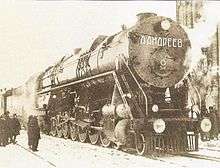4-14-4

A 4-14-4, in the Whyte notation for the classification of steam locomotives by wheel arrangement, is a locomotive with four leading wheels, fourteen coupled driving wheels (seven axles) in a rigid frame, and four trailing wheels.
Other equivalent classifications are:
UIC classification: 2G2 (also known as German classification and Italian classification)
French classification: 272
Turkish classification: 711
Swiss classification: 7/11
Russian classification: 2-7-2
AA20
| |||||||||||||||||||||||||||||
| |||||||||||||||||||||||||||||
| |||||||||||||||||||||||||||||
| |||||||||||||||||||||||||||||
| [1] | |||||||||||||||||||||||||||||
A single example of this type, called the AA20-1, was built by the Soviet Union. The designation stands for Andrey Andreev (who sponsored its construction), 20 ton axle load. While some builders had produced twelve-coupled (six driving axles) designs, no one had ever built a fourteen-coupled engine. The AA20-1 holds two records: the largest number of coupled axles on a locomotive, and being the longest rigid frame locomotive in Europe. It was the largest rigid frame locomotive in the world until 1939, when the PRR S1 was unveiled.
The large number of driving axles were meant to spread out the locomotive's weight, reducing the axle load and the resulting stress on the track. A group of Soviet locomotive engineers had visited the United States, and presumably they had seen the 4-12-2 locomotives being used by the Union Pacific. The 4-14-4 could be viewed as an expansion of that type. Unlike the successful Union Pacific locomotives, however, the AA20-1 was a complete failure.
The AA20-1 was originally intended to be a 2-14-4 (1'G2'). Construction was undertaken in Essen, Germany by Krupp, following a Soviet design. Later, the unfinished locomotive was moved to Lugansk, where a two-axle leading truck was fitted. The trailing truck supported a huge firebox. The AA20-1 was intended to run on low-quality coal, so a lot of space was needed to burn it in order to provide enough heat to the boiler.
The seven driving axles were laid out 1.7 m (5.6 ft) apart, giving a very long rigid wheelbase of 10 m (33 ft). This required adaptations to negotiate curves. The center three driving axles were blind, and the first and seventh driving axles were fitted with lateral motion devices. These measures were not enough to make the AA20-1 work properly, however. It was prone to frequent derailments, and despite its large number of wheels, it was still too heavy for the track. As a result of its long wheelbase, the AA20-1 also spread the track and wrecked the points of the switches it passed over. It was too big to fit on the turntables, too powerful for the couplers in use at the time and unable to run at full power for very long due to its undersized boiler.
The AA20-1 made a publicity trip to Moscow in 1935. It was then put into storage at the Shcherbinka test facility and finally scrapped in 1960, though this was not stated publicly.